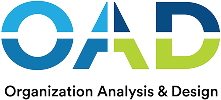Leadership development is no longer a “nice-to-have.” In today’s competitive market, it’s the backbone of organizational success. At OAD, we see mid-market companies underestimate this all the time — treating leadership as a perk instead of the very system that determines whether they grow or stall.
Yet most leadership development programs fail. According to Harvard Business Review, organizations spend billions each year on training initiatives that rarely deliver measurable results. The problem? Too many programs rely on generic workshops and short-term fixes instead of building a structured, long-term journey tailored to real business needs.
In this article, we’ll break down what makes a leadership development program effective, the pitfalls to avoid, and the strategies you can use to cultivate leaders who drive impact at every level of your organization.
Table of Contents
- Why Leadership Development Matters More Than Ever
- Common Pitfalls in Leadership Development Programs
- Defining the Goals of Your Leadership Development Program
- Core Elements of an Effective Leadership Development Program
- The Leadership Journey: From Emerging Leaders to Executives
- Embedding Leadership Development into Culture
- Measuring Impact and ROI
- Building Leadership Development That Lasts
Why Leadership Development Matters More Than Ever
Leadership isn’t a multiplier — it’s a pressure valve. In high-stress environments, the leader determines whether pressure fuels growth or causes systems to crack. When leaders are well-prepared, they elevate the people around them. Teams become more engaged, employees stay longer, and companies adapt faster to change. Think of a manager who steps in during a crisis, communicates clearly, and keeps morale steady — that single act doesn’t just save a project, it strengthens the entire team’s trust for years to come.
On the other hand, the cost of poor leadership is steep. Gallup research shows that managers account for up to 70% of the variance in employee engagement. A weak leader can derail morale, drive top performers out the door, and stall innovation — all of which come with a heavy price tag. The U.S. Department of Labor estimates the cost of a bad hire can reach 30% of that employee’s annual salary.
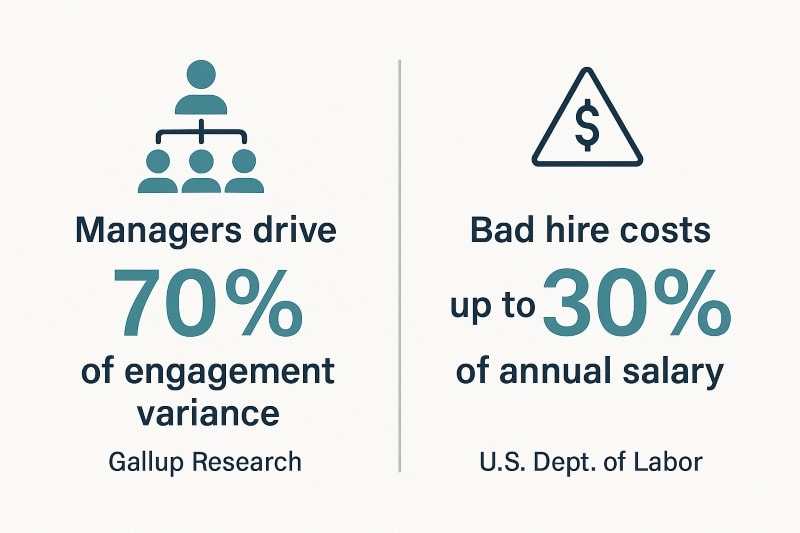
In today’s world of hybrid work, rapid change, and increasing employee expectations, leadership development has shifted from optional to essential. Companies that fail to prioritize it risk falling behind, while those that build strong leadership pipelines gain a durable competitive advantage. A focused approach to leadership development ensures that efforts are aligned with specific organizational goals and delivers measurable results.
Common Pitfalls in Leadership Development Programs
If leadership development is so critical, why do so many programs fail? The truth is, companies often approach it as a checkbox activity rather than a strategic investment.
It’s like a basketball team that only runs drills but never scrimmages. On paper, they ‘trained,’ but when the real game comes, they can’t adapt.
That’s why OAD assessments cut through the noise — instead of relying on generic, one-size-fits-all programs, we take a focused approach to leadership development. We pinpoint individual leadership blind spots so development actually sticks. Sending managers to a one-size-fits-all workshop may check the “training” box, but it rarely translates into lasting behavioral change. We’ve seen managers attend a weekend seminar, come back with binders full of notes… and within a month, nothing changes in how they lead their teams. Leadership is situational — what works for one leader in one environment may not work for another.
Another mistake is focusing too heavily on theory while neglecting practice. Leaders don’t just need to know about decision making, coaching, or conflict resolution — they need opportunities to apply these skills in real-world scenarios. Without practice, even the best frameworks fade quickly.
Finally, many organizations treat leadership development as a short-term event instead of a long-term journey. A single seminar won’t transform leadership capabilities. Sustainable development requires reinforcement, coaching, and integration into everyday work.
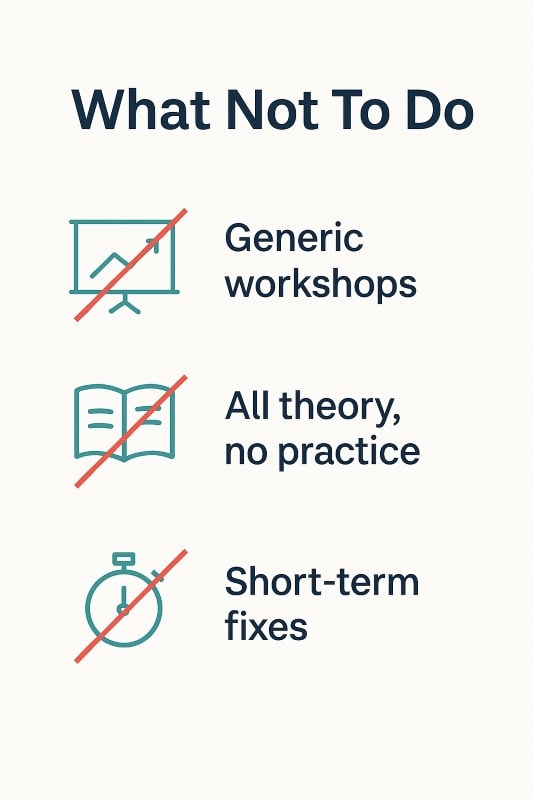
Defining the Goals of Your Leadership Development Program
A leadership development program without clear goals is like a ship without a compass — it may move, but it won’t reach the right destination. Jeff Bezos famously pushed Amazon leaders to define their ‘north star metrics’ — the same principle applies here: without clarity, leadership development drifts.
Behavioral economists call this ‘loss aversion’ — people fight harder to avoid losses than to achieve gains. Framing leadership goals around preventing costly mistakes can often motivate executives more than lofty visions of growth.

Before designing any initiative, companies need to define why they’re investing in leadership development and what outcomes they expect. It’s essential to be clear about what you want to achieve with your leadership development program, so the training can be tailored to your specific needs and desired results.
Strong programs align directly with company strategy and culture. For example, if your organization is scaling rapidly, your leaders need to master decision making under pressure and learn how to build strong teams quickly. If retention is your biggest challenge, then coaching, feedback, and people-first leadership should be at the center.
Equally important is setting measurable outcomes. Rather than vague goals like “improve leadership skills,” focus on results you can track — such as improved team performance, higher employee engagement scores, stronger succession pipelines, or reduced turnover. These benchmarks ensure the program isn’t just an HR initiative, but a business driver.
Finally, leaders must see development as a long-term journey, not a one-off exercise. Building a culture of leadership means reinforcing skills over time and connecting them to both business growth and individual career paths.
Core Elements of an Effective Leadership Development Program
An effective program goes beyond lectures and checklists. It blends learning, practice, and reinforcement in a way that helps leaders grow skills they can apply immediately. While every organization’s needs differ, the most successful programs tend to share four core elements.
Learning & Skills Development
Foundational leadership skills — communication, decision making, and emotional intelligence — are critical at every stage. Formal learning sessions should introduce these concepts, but the key is making them relevant to real workplace challenges.
Experiential Training
The best way to develop leaders is to put them in situations where they must lead. Simulations, peer learning, and real project assignments provide a safe environment to experiment, fail, and improve. Unlike theory-heavy workshops, experiential learning accelerates growth through hands-on practice.
Picture a rising manager leading a cross-functional project for the first time — stumbling, learning, and ultimately growing more in six months than in years of classroom training.
Feedback & Coaching
Leadership is shaped by self-awareness. Tools like 360-degree reviews, executive coaching, and structured feedback loops give leaders the perspective they need to recognize blind spots and build confidence. Without feedback, even skilled leaders plateau.
Support Systems
Leadership development isn’t just an event — it’s a system. Mentoring, ongoing reinforcement, and alignment with organizational practices ensure that what leaders learn doesn’t disappear after the program ends. Support structures create the consistency needed for long-term impact.
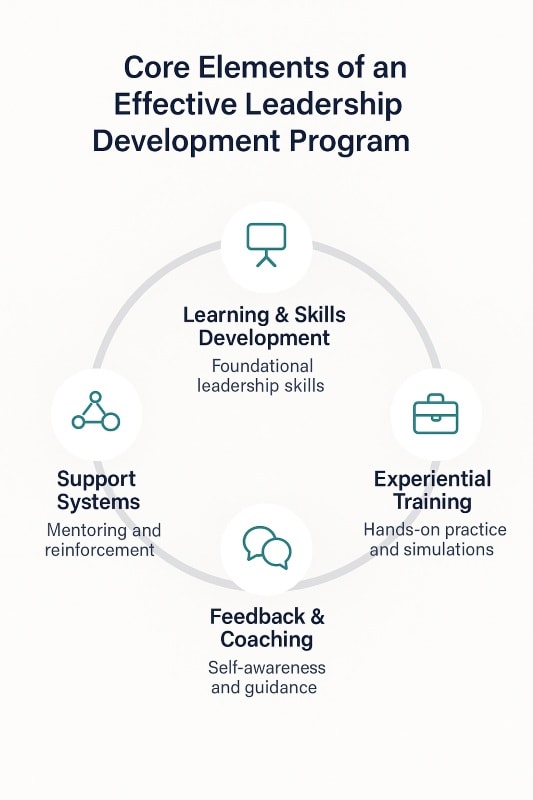
Leadership Skills Development
At the core of every effective leadership program is skills development. Strong leaders aren’t born — they’re built through intentional practice, feedback, and experience. Companies that invest in developing leadership skills consistently outperform those that don’t, with measurable gains in performance, engagement, and retention.
A well-structured program doesn’t stop at theory. It gives leaders the chance to practice communication, decision making, and strategic thinking in real-world contexts. Whether through simulations, peer learning, or coaching, the focus is on translating knowledge into action. This is where confidence grows — not from slides or lectures, but from applying new skills under pressure.
When leaders have the right tools, they can set clear goals, inspire teams, and create environments where people thrive. The ripple effects are significant: higher employee loyalty, stronger collaboration, and a culture that values continuous growth. For organizations aiming for long-term success, investing in leadership skills development isn’t optional — it’s essential.
Decision Making and Leadership
Few skills define leadership more than decision making. Every choice a leader makes — from hiring to strategy — shapes the trajectory of the business and the experience of every employee. Strong programs recognize this and put decision making at the center of leadership development.
Effective decision making isn’t about making calls quickly. It’s about analyzing complex situations, weighing trade-offs, and aligning choices with organizational goals and values. Leaders who master this skill don’t just solve problems — they set direction with clarity and confidence.
That confidence comes from practice. Through case studies, real-world scenarios, and structured feedback, leaders learn how to evaluate options under pressure and make decisions that balance short-term impact with long-term growth. Harvard Business research shows that organizations with strong decision-making cultures move faster, adapt better, and outperform competitors.
When decision making is a deliberate focus of leadership development, the benefits extend well beyond the C-suite. Teams trust leaders who make sound, consistent choices. That trust creates alignment, reduces risk, and builds a culture where employees feel empowered to act decisively themselves.
Development Program Options
No two organizations — or leaders — are the same. That’s why a one-size-fits-all approach to leadership development often falls short. The most effective companies design programs that meet leaders where they are, offering different pathways for growth depending on experience and organizational needs.
Foundational Programs
For new or emerging leaders, foundational programs focus on building core competencies: communication, decision making, and problem-solving. These skills help first-time managers transition smoothly into leadership roles, giving them the confidence to manage teams and handle everyday challenges.
Specialized Programs
For more seasoned leaders, advanced programs dig deeper into complex skill sets such as strategic thinking, innovation, and change management. These experiences prepare leaders to guide transformation, manage uncertainty, and steer organizations through periods of disruption.
When organizations understand the unique needs of their leaders, they can combine foundational and specialized development into a tailored program. This ensures that every leader — whether just starting their journey or managing at the executive level — has the tools, support, and resources to grow. The result is a leadership pipeline that strengthens the company’s long-term performance and resilience.
The Leadership Journey: From Emerging Leaders to Executives
Leadership isn’t a single destination — it’s a journey that evolves at every stage of a career. A strong development program recognizes this progression and equips leaders with the right tools at the right time. Members of leadership development cohorts or peer groups support each other throughout this journey, sharing experiences and insights that accelerate growth.
Emerging LeadersFor new managers and high-potential employees, the shift from individual contributor to leader can be overwhelming. They often struggle with confidence, delegating to former peers, and balancing their own workload with managing others. Programs at this stage should focus on foundational skills like communication, giving feedback, and building trust.
At OAD, we see this as the ‘identity shift’ moment — where people must stop measuring success by their own output and start measuring it by the success of others.
Mid-Level LeadersAs leaders advance, their responsibilities expand beyond individual teams. Department heads and senior managers must learn to lead leaders, think strategically, and influence across the organization. Development here should emphasize systems thinking, coaching others, and managing organizational change.
Executives and Senior LeadersAt the highest levels, leadership is about shaping vision, culture, and long-term strategy. Executives must balance innovation with risk management, align stakeholders, and ensure succession planning. Programs designed for this level should focus on resilience, cultural stewardship, and organizational impact.
By mapping the full leadership pipeline — from first-time managers to seasoned executives — companies ensure continuity, stability, and future-ready leaders. With tools like OAD’s personality and talent assessments, organizations can identify strengths, uncover blind spots, and provide the right support at every stage.
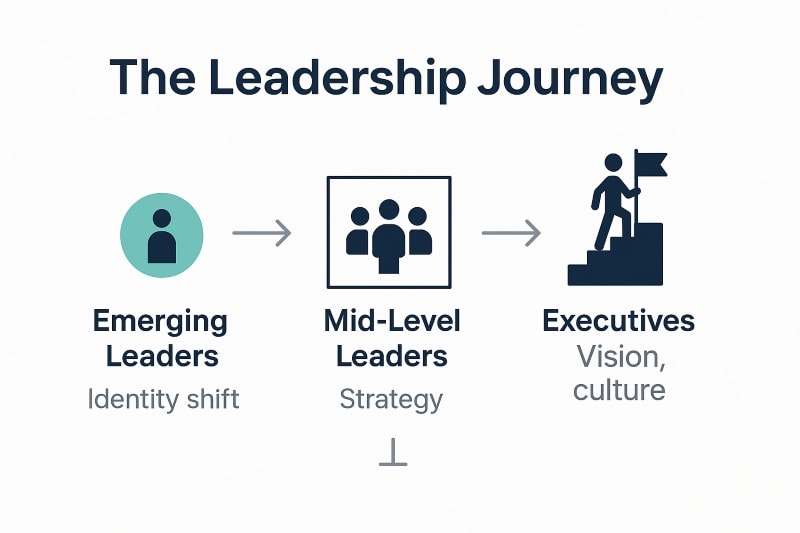
Leadership Development Challenges
The value of leadership development is undeniable — but putting it into practice isn’t always easy. Many organizations face obstacles that can stall or even derail their efforts.
Time and resources are often the biggest barriers. In fast-paced environments, dedicating hours to development programs can feel like a luxury. Leaders themselves may struggle to step away from daily demands long enough to focus on growth, even when they know it’s essential.
Another challenge lies in skill gaps. Not every leader naturally excels at communication, decision making, or people management. Without targeted support, these gaps can persist — undermining both the leader’s effectiveness and the team’s performance.
The solution is making leadership development a true strategic priority. That means integrating learning into the flow of work through on-the-job practice, peer learning, and formal programs. It also requires building a culture that values leadership growth, so that development isn’t an optional extra, but a core expectation at every level.
When companies address these challenges directly, they create the conditions for leaders to thrive. The result is stronger teams, faster business growth, and organizations that can adapt even in times of constant change.
Embedding Leadership Development into Culture
The most effective organizations don’t see leadership development as a program with a start and end date — they treat it as part of their culture. When leadership growth becomes embedded in daily operations, it creates a system where leaders are continuously learning, modeling, and reinforcing desired behaviors.
This cultural integration starts with senior leaders. When executives actively participate in development initiatives — not just as sponsors but as role models — it signals that leadership growth is a priority for everyone, not just new managers.

Warren Buffett often says culture eats strategy for breakfast — embedding leadership into systems ensures culture doesn’t just survive, it scales. Performance reviews, succession planning, and promotion decisions should reflect not only technical results but also leadership behaviors. By rewarding leaders who coach, develop others, and uphold organizational values, companies reinforce that leadership is more than hitting KPIs.
In the Navy SEALs, culture isn’t talked about in boardrooms — it’s tested on the field, every day. Leadership development works the same way: culture sticks when it’s reinforced under pressure, not when it’s written on posters.
Over time, this creates a leadership-driven culture where employees at every level understand that growing as a leader is part of the job — not an optional add-on. That cultural mindset is what differentiates companies that sustain success from those that stagnate.
Measuring Impact and ROI
Leadership development is an investment, and like any investment, it should deliver measurable returns. Without tracking impact, programs risk being seen as “soft” initiatives rather than drivers of business performance.
The first step is defining clear metrics. Common measures include employee engagement scores, team performance, retention rates, and promotion readiness. For example, if your goal is to strengthen decision making, you might measure improvements in project success rates or the speed and quality of executive decisions.
Financial outcomes also matter. Companies that link leadership development to revenue growth, cost savings, or productivity gains are better positioned to secure long-term support for these initiatives. Harvard Business Review notes that organizations with strong leadership pipelines consistently outperform peers in profitability and innovation.
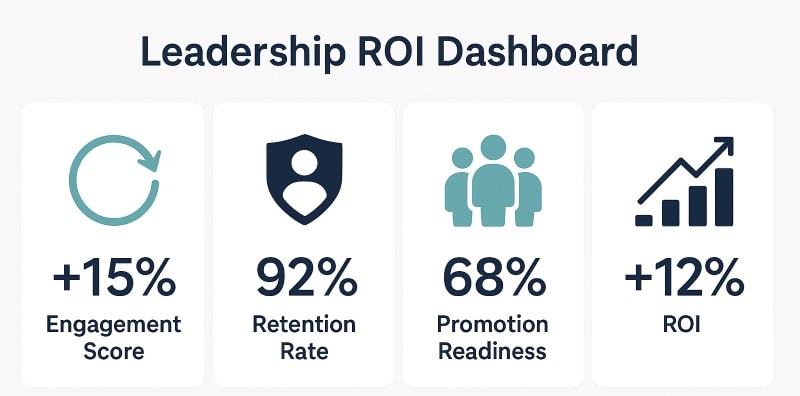
HBR proves the business case, but OAD’s data shows why — leaders who match their natural strengths to the right roles sustain performance over time.
Equally important is measuring long-term outcomes, not just short-term training satisfaction. Post-program surveys provide useful feedback, but the real test is whether leaders apply what they’ve learned six months, a year, or even three years later. That requires ongoing tracking, coaching, and data-driven assessments.
Building Leadership Development That Lasts
The strongest leadership development programs don’t just create capable managers — they create a sustainable pipeline of leaders who can guide the organization into the future. To achieve this, companies must blend proven practices with adaptability.
Best-in-class organizations go beyond training by combining science and coaching. Assessments like OAD’s provide the data-driven insights needed to understand strengths, blind spots, and leadership potential. When paired with mentoring and real-world practice, these insights turn into long-term growth.

Another hallmark of lasting leadership development is future-proofing. The business landscape will continue to evolve, and leaders must be ready to handle new challenges — from hybrid work structures to global competition. By equipping leaders with adaptability, resilience, and self-awareness, companies ensure they stay competitive no matter what the future brings.
Leadership development is the single most powerful investment you can make in your company’s future. But success requires more than good intentions — it takes a science-backed approach, continuous support, and alignment with business goals.
Unlike most programs that fade after the workshop, OAD equips leaders with tools they’ll still be using — and still benefiting from — three years later.
Test OAD for free today and see how data-driven insights can transform your leadership pipeline.
